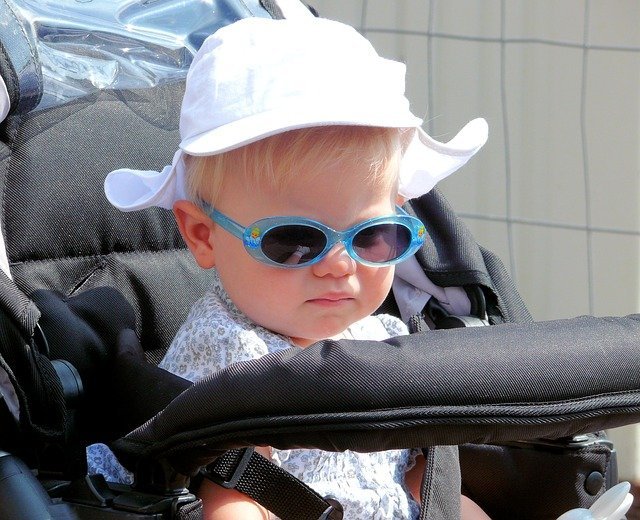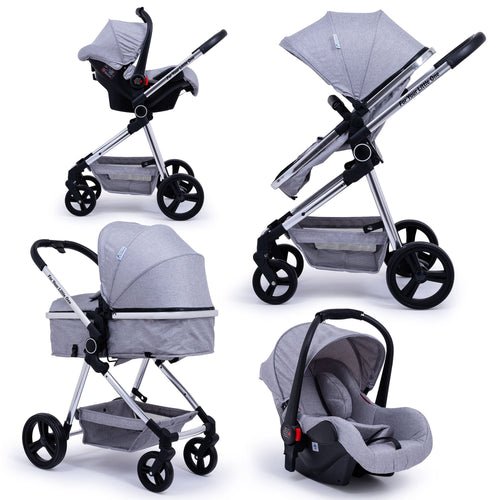Moses baskets are a brilliant option for newborn babies, but it's important to transition to a sturdier cot or crib when they get too big. In this blog, we'll help you to understand when to take baby out of Moses basket and move them into a cot, and give you some tips on how to transition your baby into sleeping in their bedroom.
How do I know when to take baby out of Moses basket?
The wicker or palm leaf construction of
Moses baskets makes them robust enough for newborns, but not strong enough for babies weighing more than 6 to 7 kg (around 13 to 15 lbs). Maximum weight limits vary from basket to basket, but most are within this 6 to 7 kg range. Plus, Moses baskets are fairly shallow, which is fine for babies who are not yet strong enough to roll over by themselves but dangerous for those who can. If a baby rolls over in a Moses basket there is a risk their movement could tip the basket over and they could become injured. Most babies begin to start rolling over unaided as early as 3 or 4 months old. At this age, they will also be reaching around 6 to 7 kg in weight. You should therefore think about transitioning your baby into a cot when they reach three months, but every baby grows and develops at their rate so keep an eye on their weight and lookout for signs that they're trying to roll over.
What should baby sleep in after a Moses basket?
Now you know when to take baby out of Moses basket, you need to consider what they will move into. Ideally, your baby should transition to a cot. This could be a
cot bed that is large enough to cater for them up to the age of three or four years. However, at the age of three or four months, your baby should ideally remain in the same room as you, and a cot bed might be too big and bulky to fit in your bedroom. In this instance, a bedside crib or a travel cot might be a better option.
Bedside cribs are those which are designed to sit right up against the edge of the bed so that baby sleeps alongside their parent. This close contact is thought to support bonding and help the baby to feel secure, and it makes bedtime feeds a little less stressful and tiring. Weight limits for bedside cribs tend to be around 9 or 10 kg (around 20 to 22 lbs), which means they're suitable for use until the little one is around a year old.
Travel cots tend to be fairly compact so that they don't take up too much space. They're also portable so that you can fold them down and put them out of the way whenever you need a bit more space in your bedroom and the baby isn't sleeping. They're usually suitable up until the age of 9 to 12 months, but weight limits vary so be sure to check before purchasing.
How soon can a baby sleep in their own room?
The
NHS recommends that parents should have their baby sleep in the same room as them for the first six months to reduce the risk of Sudden Infant Death Syndrome (SIDS). Many parents choose to keep the baby with them for even longer because it's easier to manage feeds and nappy changes when the baby is close by. However, it's important to note that having a baby in the same room does seem to result in parents
getting less sleep overall because they are more likely to get woken up by every little noise baby makes while sleeping. After the first six months, weigh up the pros and cons of having a baby sleep in the same room; if getting better quality sleep feels more important than the convenience of having your baby close by, it might be best to transition them into their bedroom. It can be tricky for babies to adjust to sleeping in a new room at first. You can expect there to be lots of tears for the first few nights at least. To make the process easier, it can be helpful to begin spending more time in the baby's soon-to-be bedroom for a month or two before the transition. You can use it for feeding, naps, or general cuddles to make it a space associated with being calm and soothed. When the time comes for babies to sleep in the room at night, soothe them whenever they get fussy or protest, and then put them down again as soon as they calm down. You may need to repeat this process a few times as your little one adjusts to the idea that you're still there for them when they need you, even if you aren't in the same room.
When is the right age to transition a toddler into a bed?
Moving your toddler out of a crib and into a toddler bed is a big step, and there's no right or wrong time. Some people make the move as early as 18 months old, while others wait until 3 or 4 years. The decision may well come down to the size, weight and age limits of the cot in which your little one is sleeping. For some parents, the decision is dictated by the impending arrival of a new baby who will soon need the cot. It's also important to consider how active your toddler is. If they're climbing on the side rails of their cot and there's a risk they could clamber over and injure themselves, it's important to move them into a toddler bed for a matter of safety. Keep in mind that some cots, particularly cot beds, are adjustable so that the mattress can be lowered as the toddler grows so that they can't climb out.



